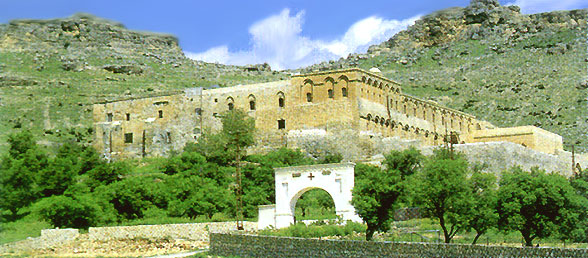 |
| MOR HANANYO DAYRO |
|
The Syriac Orthodox Monastery established in the 5th century |
|
(view of the monastic complex from the southwest) |
The monastery Mor Hananyo, also known as Kurkmo Dayro (in Syriac) or Deir ez-Za`faran (in Arabic) meaning the "Saffron Monastery", is situated some five kilometers east of Mardin (in South eastern Turkey), in a shallow basin half-way up the side of the mountain ridge. This is one of the most known and ancient structure of Upper Mesopotamia, and the religious center of the Süryani Kadim (Syrian Orthodox) Community. The origins of this imposing monastery goes back to the 5th century; mosaics remaining from that period have still been present. From 1293 until 1932 it was the official seat of the Syrian Orthodox Patriarchate of Antioch and all the East. Tradition associates the monastery's foundation with a certain Shleymun (Solomon), about whom little or nothing is known.
The name "Saffron monastery" is said to derive from the saffron dye used in the building's plaster-work; the correct name, however, is the "Monastery of Mor Hananyo (St. Ananias)" who was the Metropolitan of Kfartuta (793-800). It was he who renovated the monastery buildings after a period of decline in 793. An earlier dedication, to Mor Augen, is still remembered much later by some scribes who refer to it as the monastery of Mor Hananyo and Mor Augen. Further important renovation work was done by an energetic bishop of Mardin, John, who died at the monastery on 12th July 1165. The most ancient buildings of the monastery are the main church, the Church of the Mother of God, and the Beth Kadishe. They are said to have been erected on the ruins of a Roman castle and a pagan temple. The monastery possessed a fine library with valuable manuscripts and books.
| Left: The 6th century Patriarchal throne in the main church of the monastery | |
| Middle: The interior of the main church built in the early sixth century | |
| Right: The ancient Altar in the Chapel of the Mother of God | |
|
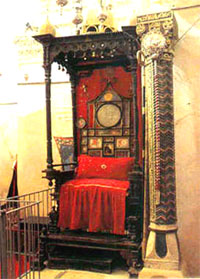 |
|
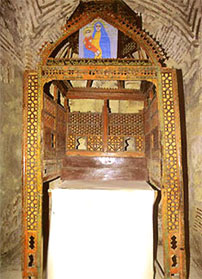 |
| The building inside the Monastery complex which was originally a pagan temple with a flat stone vault |
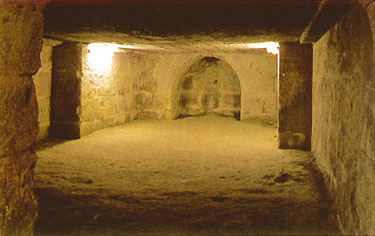 |
Church Architecture
The various churches and buildings of the monastery still preserve a great deal of the original decoration and sculpture, many of the details of which are of very high artistic quality. Here the well preserved main church, with its impressive proportions and fine carved decoration, dates back to the sixth century, as does the adjacent funery chamber to the north. Set in a niche in one of the reception rooms is a carved stone panel surrounded by a long decorative Syriac inscription. On the panel, which is very much older than the inscription, there is a cross, set on a step and with a sheep on either side paying reverence. Though not particularly eye-catching, the panel is of great importance since it can be identified as the back of the "Throne of Antioch: which sympolises the apostolicity of the Patriarchate of Antioch and all the East.
Among the many items in the monastery special mention should be made of the sixth century Patriarchal throne, and the wooden doors of the main church which are inlaid with a long inscription giving excerpts from the Psalms in Syriac.
In the vicinity of the monastery, to the north, are three small monasteries, dedicated to the bearer of God (also called "of the dripping water [Noto]"), to Mor Ozoziel, and to Mor Jacob of Serug ("the Teacher").
| Right: The powerful south facade with the steps up to the gate |
| Left: The courtyard in the Monastery |
|
|
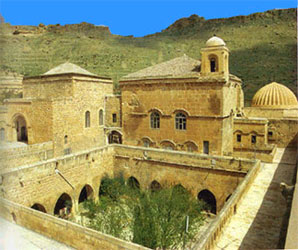 |
Manuscripts in the Monastery
A large number of manuscripts covering many subjects is known to have been written at Deir ez-Za`faran, thus providing testimony to the varied intellectual interest of the monks. These are by no means restricted to religious matters; thus, for example, a manuscript copied in 1308-09 contains the Syriac translation of Ptolemy's Tetrabiblon and Severus Sebokht's Treatise on the Constellations. One of the most luxurious Syriac Manuscripts to survive is the Lectionary of Deir ez-Za`faran, copied in the middle of the thirteenth century by Dioscrous Theodorus, who later became bishop of Hesna d-Ziyad (Kharput). Besides having twenty miniatures inserted in the text, the manuscript is strewn with ornaments in the form of colourful circles, crosses, stars and bands, the last serving as the background for titles and rubrics, Full-page Crosses introduce and close the canon Tables, and the title frontispiece is presented under a gold portion. The miniatures within the interlaced borders in red, blue and yellow follow Byzantine iconographical formulas closely. The background included both architecture and elements of landscape. Moreover, the physiognomic type of the person is not 'islamicised'. There is a Bible of great historical value and a sacred stone in the monastery, from where the first School of Medicine is to thought to have been established.
On the first visit of any Syrian Orthodox Patriarch to England, in the winter of 1874-75, Mor Ignatius Pathros IV took the opportunity to have a printing press sent back to the monastery, and once it had been installed it was put to good use in the printing of a number of liturgical and other books in Syriac.
| Left: Harvest basket above a Syriac inscription telling the history of the persecution of the Syrian Orthodox patriarchate after the three Ecumenical Councils, which it recognizes, and its various migrations; Middle: Monastery surrounded by gardens; Right: The fountain house to the southwest of the Monastery |
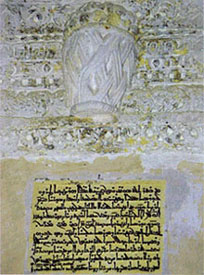 |
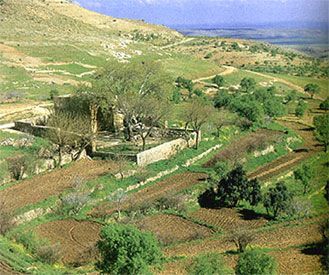 |
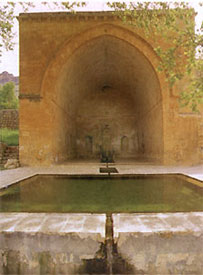 |
Scholars from the Monastery
Of the many Syriac scholars and authors who have
been monks at Deir ez-Za`faran, three stand out for their exceptional learning.
The first is a prolific author of the eighth-ninth century, Iwannis of Dara;
before he was appointed Metropolitan of Dara in 825 he had been a monk at the
monastery, and it was presumably there that he had access to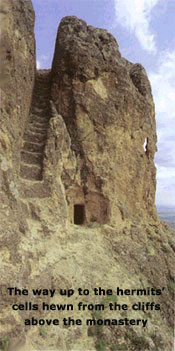 an extremely
well-stocked library, the fruits of which can be seen in his writings, the other
two both belong to modern times. Although born at Mosul (in 1887),
the
Patriarch Ignatius Ephrem Barsaum (1933-57) studied and became a monk at the
monastery; he possessed an incomparable knowledge of Syriac literature, the
fruits of which can be seen in his invaluable History of Syriac literature.
Although this book was written in Arabic, it was translated into Syriac by
another monk of the monastery, Metropolitan
Mor Philoxenos Yuhanon Dolabani
(1947-69). Mor Dolabani was also a scholar in his own right, being the author of
numerous important works in Syriac, Arabic and Turkish, Among these are detailed
catalogues, made at the beginning of the 20th century, of the rich manuscript
holdings both of this monastery and of St. Mark's in Jerusalem.
an extremely
well-stocked library, the fruits of which can be seen in his writings, the other
two both belong to modern times. Although born at Mosul (in 1887),
the
Patriarch Ignatius Ephrem Barsaum (1933-57) studied and became a monk at the
monastery; he possessed an incomparable knowledge of Syriac literature, the
fruits of which can be seen in his invaluable History of Syriac literature.
Although this book was written in Arabic, it was translated into Syriac by
another monk of the monastery, Metropolitan
Mor Philoxenos Yuhanon Dolabani
(1947-69). Mor Dolabani was also a scholar in his own right, being the author of
numerous important works in Syriac, Arabic and Turkish, Among these are detailed
catalogues, made at the beginning of the 20th century, of the rich manuscript
holdings both of this monastery and of St. Mark's in Jerusalem.
The monastery in its long history has produced 21 Patriarch's, 7 Maphriyono's and 111 Episcopos. This ancient monastery have the tombs of 52 Syrian Orthodox Patriarchs which makes its a very important place for the Syrian Christians. The last of the canonical patriarchs entombed in this monastery is Moran Mor Ignatius Pathros IV who died on 8 October 1894. This monastery continued to be the church headquarters till the time of Patriarch St. Ignatius Elias III who passed away in 1932 during a visit to Kerala (India). The seat of the Patriarchate since then was moved to Homs and then to Damascus.
Mor Philoxenos Saliba Özmen, ordained on 9 February 2003 as the Metropolitan for the diocese of Mardin is now residing in the Mor Hananyo monastery which was the headquarters of the Patriarchate of Antioch & all the East for about eight centuries.
|
|
|
| The Archbishop, the abbot, monks and priests with the Church council members of Mardin and Bnebil at the Mor Hananyo Monastery. (1999) |
|
|
|
| Main source: |
| Hollerweger Hans: Living Cultural Heritage TURABDIN, 1999 |
| Other References: |
| S P Brock, 'The Hidden Pearl' (2001) |
|
Related Links: |
|
1. Official site - http://www.deyrulzafaran.org |
|
2. Syriac Orthodox Resources- http://sor.cua.edu/ChMon/MardinDKurkmo/index.html |

|
This is not an official website of the church & the Monastery |